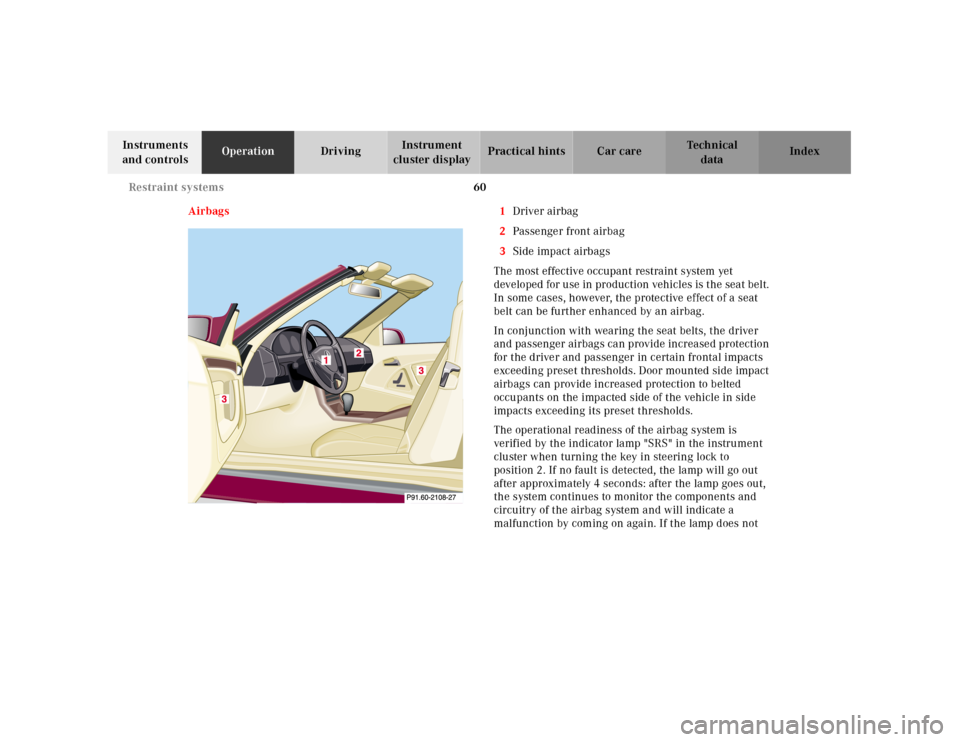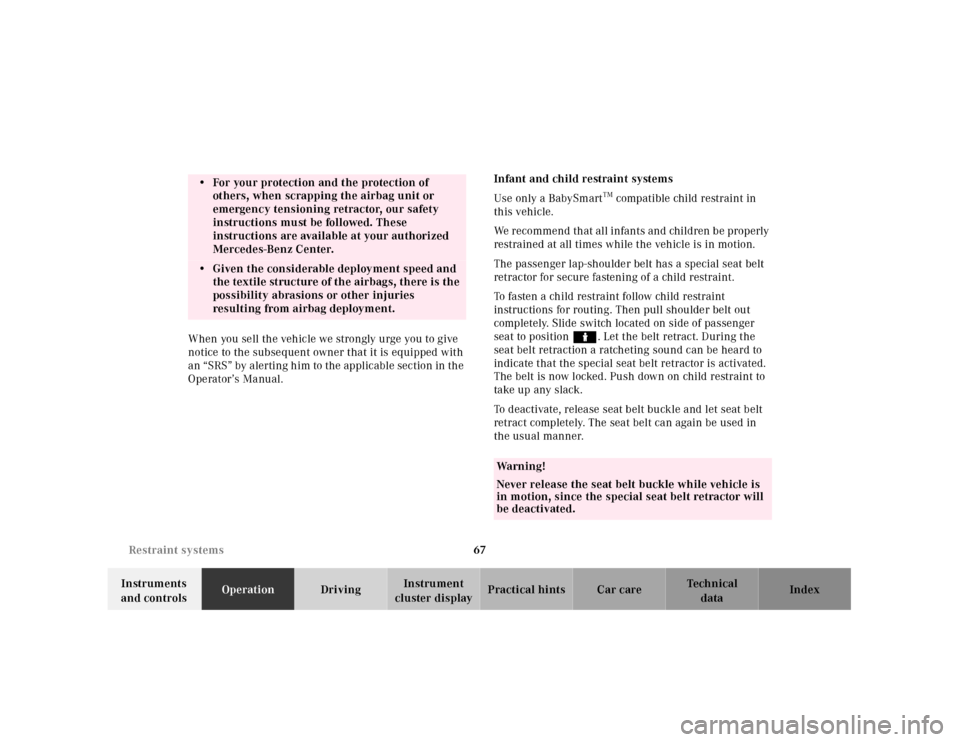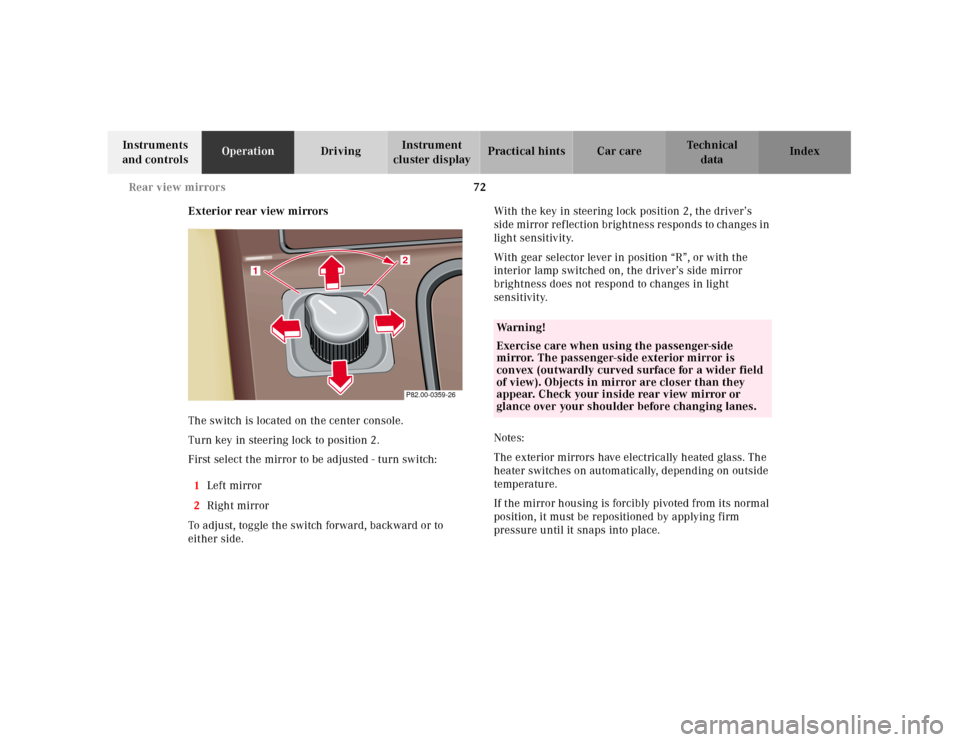Page 63 of 297

59 Restraint systems
Technical
data Instruments
and controlsOperationDrivingInstrument
cluster displayPractical hints Car care Index Supplemental restraint system (SRS)
Airbags are intended as a supplement to seat belts.
Airbags alone cannot protect as well as airbags plus
seat belts in impacts for which the airbags were
designed to operate, and do not afford any protection
whatsoever in crashes for which the airbags are not
designed to deploy.
The SRS uses two crash severity levels (thresholds) to
activate either the emergency tensioning retractor (ETR)
or front airbag or both. Activation depends on the
direction and severity of the impact exceeding the
preset thresholds and whether the seat belt is fastened.
Seat belt fastened
• first threshold exceeded:
ETR activates
• second threshold exceeded:
airbag also activates
Seat belt not fastened
• first threshold exceeded:
airbag activates, but not ETR
Driver and passenger systems operate independently of
each other.Emergency tensioning retractor (ETR)
The seat belts are equipped with emergency tensioning
retractors. These tensioning retractors are located in
each belt’s inertia reel and become operationally ready
with the key in steering lock position 1 or 2.
The emergency tensioning retractors are designed to
activate only when the seat belts are fastened during
frontal and front-angled impacts and rear impacts
exceeding the first threshold of the SRS and in rear
impacts exceeding a preset severity level. They remove
slack from the belts in such a way that the seat belts fit
more snugly against the body restricting its forward
movement as much as possible.
In cases of other frontal impacts, rollovers, certain side
impacts, rear collisions or other accidents without
sufficient frontal or rear impact forces, the emergency
tensioning retractors will not be activated. The driver
and passenger will then be protected by the fastened
seat belts and inertia reel in the usual manner.
For seat belt and emergency tensioning retractor safety
guidelines see page 66.
Page 64 of 297

60 Restraint systems
Technical
data Instruments
and controlsOperationDrivingInstrument
cluster displayPractical hints Car care Index
Airbags 1Driver airbag
2Passenger front airbag
3Side impact airbags
The most effective occupant restraint system yet
developed for use in production vehicles is the seat belt.
In some cases, however, the protective effect of a seat
belt can be further enhanced by an airbag.
In conjunction with wearing the seat belts, the driver
and passenger airbags can provide increased protection
for the driver and passenger in certain frontal impacts
exceeding preset thresholds. Door mounted side impact
airbags can provide increased protection to belted
occupants on the impacted side of the vehicle in side
impacts exceeding its preset thresholds.
The operational readiness of the airbag system is
verified by the indicator lamp "SRS" in the instrument
cluster when turning the key in steering lock to
position 2. If no fault is detected, the lamp will go out
after approximately 4 seconds: after the lamp goes out,
the system continues to monitor the components and
circuitry of the airbag system and will indicate a
malfunction by coming on again. If the lamp does not
Page 65 of 297

61 Restraint systems
Technical
data Instruments
and controlsOperationDrivingInstrument
cluster displayPractical hints Car care Index come on at all or if it fails to extinguish after
approximately 4 seconds or if it comes on thereafter, a
malfunction in the system has been detected.
The following system components are monitored or
undergo a selfcheck: crash-sensor(s), airbag ignition
circuits, seat belt buckles, emergency tensioning
retractors, seat sensor.
Initially, when the key is turned from steering lock
position 0 to positions 1 or 2, malfunctions in the crash-
sensor are detected and indicated (the “SRS” indicator
lamp stays on longer than 4 seconds or does not come
on). In the operational mode, after the indicator lamp
has gone out following the initial check, interruptions or
short circuits in the airbag ignition circuit and in the
driver and passenger seat belt buckle harnesses, and
low voltage in the entire system are detected and
indicated.Have the system checked at your authorized
Mercedes-Benz Center immediately.
Wa r n i n g !
In the event a malfu nction of th e “SRS” is indic ated
as outlined above, the “SRS” may not be
operational. For your safety, we strongly
recommend that you visit an authorized
Mercedes-Benz Center immediately to have the
system checked; otherwise the “SRS” may not be
activated when needed in an accident, which could
result in serious or fatal injury, or it might deploy
unexpectedly and unnecessary which could also
result in injury.
Page 71 of 297

67 Restraint systems
Technical
data Instruments
and controlsOperationDrivingInstrument
cluster displayPractical hints Car care Index When you sell the vehicle we strongly urge you to give
notice to the subsequent owner that it is equipped with
a n “SRS” by a lerting h im to the appl ic abl e sec tion in th e
Operator’s Manual.Infant and child restraint systems
Use only a BabySmart
TM compatible child restraint in
this vehicle.
We recommend that all infants and children be properly
restrained at all times while the vehicle is in motion.
The passenger lap-shoulder belt has a special seat belt
retractor for secure fastening of a child restraint.
To fasten a child restraint follow child restraint
instructions for routing. Then pull shoulder belt out
completely. Slide switch located on side of passenger
seat to position N. Let the belt retract. During the
seat belt retraction a ratcheting sound can be heard to
indicate that the special seat belt retractor is activated.
The belt is now locked. Push down on child restraint to
take up any slack.
To deactivate, release seat belt buckle and let seat belt
retract completely. The seat belt can again be used in
the usual manner.
• For your protection and the protection of
others, when scrapping the airbag unit or
emergency tensioning retractor, our safety
instructions must be followed. These
instructions are available at your authorized
Mercedes-Benz Center.• Given the considerable deployment speed and
the textile structure of the airbags, there is the
possibility abrasions or other injuries
resulting from airbag deployment.
Wa r n i n g !
Never release the seat belt buckle while vehicle is
in motion, since the special seat belt retractor will
be deactivated.
Page 74 of 297
70 Adjusting steering column
Technical
data Instruments
and controlsOperationDrivingInstrument
cluster displayPractical hints Car care Index
Adju st in g steerin g c olu mn
Turn key in steering lock to position 1 or 2 (with either
door open, the steering column can be operated with the
key removed or in steering lock position 0).
To extend or retract:
Move switch (1) in desired direction.
To raise or lower:
Move switch (1) in desired direction.Storing steering column position in memory
The steering column position is stored in memory
together with the seat/heat restraint/exterior rear view
mirror position and can be recalled when necessary,
see memory recalling on page 46.
Wa r n i n g !
Do not adjust the steering wheel while driving.
Adjusting the steering wheel while driving, or
driving without the telescoping adjustment locked
could cause the driver to lose control of the vehicle.
Page 75 of 297

71 Rear view mirrors
Technical
data Instruments
and controlsOperationDrivingInstrument
cluster displayPractical hints Car care Index Rear view mirrors
Inside rear view mirror
Manually adjust the mirror.
Use your inside mirror to determine the size and
distance of objects seen in the passenger side convex
mirror.
Antiglare night position
With the key in steering lock position 2, the mirror
reflection brightness responds to changes in light
sensitivity.
With gear selector lever in position “R”, or with the
interior lamp switched on, the mirror brightness does
not respond to changes in light sensitivity.Note:
The automatic antiglare function does not react, if
incoming light is not aimed directly at sensors in the
mirror.
Wa r n i n g !
In the case of an accident liquid electrolyte may
escape the mirror housing when the mirror glass
breaks.Electrolyte has an irritating effect. Do not allow the
liquid come into contact with eyes, skin, clothing,
or respiratory system. In cases it does, imm edi ately
flush affected area with water, and seek medical
help if necessary.
Page 76 of 297

72 Rear view mirrors
Technical
data Instruments
and controlsOperationDrivingInstrument
cluster displayPractical hints Car care Index
Exterior rear view mirrors
The switch is located on the center console.
Turn key in steering lock to position 2.
First select the mirror to be adjusted - turn switch:
1Left mirror
2Right mirror
To adjust, toggle the switch forward, backward or to
either side.With the key in steering lock position 2, the driver’s
side mirror reflection brightness responds to changes in
light sensitivity.
With gear selector lever in position “R”, or with the
interior lamp switched on, the driver’s side mirror
brightness does not respond to changes in light
sensitivity.
Notes:
The exterior mirrors have electrically heated glass. The
heater switches on automatically, depending on outside
temperature.
If the mirror housing is forcibly pivoted from its normal
position, it must be repositioned by applying firm
pressure until it snaps into place.
2
1
P82.00-0359-26
Wa r n i n g !
Exercise care when using the passenger-side
mirror. The passenger-side exterior mirror is
convex (outwardly curved surface for a wider field
of view). Objects in mirror are closer than they
appear. Check your inside rear view mirror or
glance over your shoulder before changing lanes.
Page 79 of 297
75 Instrument cluster
Technical
data Instruments
and controlsOperationDrivingInstrument
cluster displayPractical hints Car care Index 1Fuel gauge with reserve and fuel cap placement
warning lamp (yellow), see page 207
2Coolant temperature gauge, see page 78
3Fuel consumption gauge, see page 83
4Engine oil temperature gauge, see page 83
5Left turn signal indicator lamp (green),
see combination switch on page 86
6K nob for intensity of instrum ent l amps, see pa ge 77,
for resetting trip odometer, see page 79 and
for calling up FSS indicator, see page 80
7Speedometer8EPS warning lamp (yellow), see page 207
9Odometer display field, see page 82
10Main/trip odometer, see page 79
or FSS indicator, see page 80
or engine oil level indicator, see page 82
11Outside temperature indicator, see page 78
12Right turn signal indicator lamp (green),
see combination switch on page 86
13Tachometer, see page 79
14Knob for setting clock, see page 79
15Clock, see page 79